The insurgent accounts of witness
Jan Romanczyk "Łata" (= a patch) - the boy from "Miotła" (= a broom)
Ursus
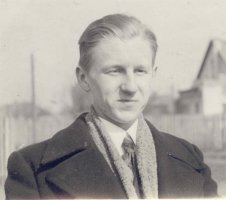 |
Jan Romanczyk
born on the 1st of May 1924 in Wolomin
sergeant cadet of Home Army
pseud. "Łukasz Łata" (= Lucas the Patch)
Kedyw of the Main Headquarters of Home Army
"Torpeda" (= a torpedo) Platoon, "Miotła" (= a broom) Battalion
"Radoslav" Grouping
|
After the Uprising capitulation the majority of the fighting of about 16,000 went to the German imprisonment together with the commanding officer of Home Army Gen. "Bor"(= a forest) Komorowski. Before the capitulation was signed Gen. "Bor" arranged with Gen. Okulicki "Niedzwiadek" (= a cub) that the latter would stay with the country and would continue the underground movement activity and a fight with Germans. On the 4th of October Gen. "Niedzwiadek" together with Colonel "Radoslaw" slipped out from the civilians of Warsaw. Together with them similarly 3,500 soldiers left Warsaw, including many members of Kedyw.
Lots of survived friends from "Miotła" didn't go to the imprisonment, They got an order of getting back to the field and of establishing contacts. I greeted them really cordially. The contact with us was established by the commanding officer Second Lieutenant Kazimierz Jackowski "Torpeda." We got 10 dollars of pay and I got a promotion for the rank of sergeant cadet. All sergeants that lasted out till the capitulation got a promotion for the rank of second lieutenants. Our group after regenerating the structures got an order of going to Czestochowa to protect the Home Army Main Headquarters. I got a proposal as well but I didn't feel very good after the injury so I'd refused. Some part of soldiers took up the underground activity in the near-Warsaw regions.
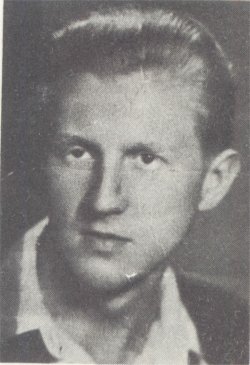
Jan Romanczyk 1945
After some time a woman liasion officer came to me so that I reported in Piastow for the meeting with Second Lieutenant Seweryn Skowronski "Anatol." We talked about organization matters and I got an order of being in touch with friends that stayed in the field. "Anatol" told me that "Torpeda" had been suspended in performing the function of the platoon commanding officer and I was to take over his responsibilities. I didn't take note of it. I said that the platoon commanding officer had his second in command and I wasn't that person. I couldn't usurp the title of unit commanding officer. But I could contact "Anatol" with "Torpeda"'s second in command Wladyslaw Dlugolecki pseud. "Borek." I organized the meeting of "Borek" with Leszek Nizinski pseud. "Niemy"(= mute) that represented "Anatol."
Germans held man-hunts and deported young people caught by Germans. There was a duty to defend oneself from such an eventuality. The factory in Ursus was the branch of Dulag (a temporary camp) in Pruszkow. Here the civilians, expelled from Warsaw after the Uprising, were brought and then so were the stolen things from houses. People from Ursus area were employed for sorting those things. They reported that Germans were mining the factory. The mines were being laid under each pillar in all halls. There was a rail gun standing on the factory area.
For Christmas Second Lieutenant "Torpeda" got back from Czestochowa to Ursus with his platoon soldiers. After Christmas "Torpeda" together with his group returned again to Czestochowa. Unfortunately he didn't manage to get in touch with the organization. In this situation everyone got back to Ursus. They were joined by the platoon soldiers who injured stayed on Ursus area. We started making plans of saving the factory. From the reconnaissance cells "Torpeda" got confirming news that Germans were preparing the explosion of the production halls of the factory of the State Engineering Plant in Ursus. German sappers laid mines in the whole factory area joining every explosive charge with a complicated system of detonators.
In the first days of January 1945 "Torpeda" organized in his house at Mickiewicza Street in Ursus the platoon briefing. He acquainted soldiers with the political-military situation and with German plans towards the factory in Ursus. To prevent them he gave appropriate orders. One part of soldiers was to make a reconnaissance of the location of the explosive charges, what the condition of German crew was and what the access road looked like. Another group was to get in touch with people from the Fire Brigade and RGO (= Central Welfare Council) who had access to the factory halls. The latter was engaged then in the liquidation of Dulag remains. The preliminary date of carrying out the action was arranged for 10.01.1945. The date and the place of the next briefing was to be given by a woman-liaison officer. Taking up actions connected with saving the factory "Torpeda" probably didn't know that he was suspended as a commanding officer.
On 10.01.1945 the next briefing took place in the building at Orlicz-Dreszer 15 Street. Individual section-representatives reported on their reconnaissance. The outline of the situation showed that all production halls were mined and so were the two flyovers on the route Wlochy-Golabki. The number of a German unit stationed in the factory was assessed for 30 people. At night they rather stayed in the office block.
"Torpeda" ordered the commanding officer of every group to present their action plan. Having heard out the propositions and carrying out the discussion. "Torpeda" gave appropriate orders. For the action of cleaning the State Engineering Plant of mines. For "Ursus" and a flyover he appointed three groups.
The first group consisted of "Zmudzki" + three was to enter the area of the factory from the side of the Kosinskis' house.
The second group consisted of "Zelazny" + three was to enter the factory area near the house where dr. Ulawska lived.
The third group led by "Wilk" (= a wolf) was to enter behind the Pattern Shop from the side of the street running on Szamotuly along the factory fence.
The whole action was directly led by "Torpeda."
First two groups were mine-groups. Their fields of action were following:
- the first group: the assembly with the tool-room, the station of compressors and a part of the mechanics department
- the second group: a foundry, a smithy, a hardening point and a help on the mechanics department
- the third group : it secured the entrance and the office block were Germans stayed
The roads of withdrawal like the access ones while the emergency exit behind the smithy on Szamotuly village.
"Torpeda" announced a combat alert. Individual groups had to have guns on alert and tools necessary in the job of the mine liquidation. The commanding officers were to practise with soldiers the task carrying out. The job was made easier by the fact that almost everyone was a factory worker of many years standing. The time of intensive training and waiting ensued.
13.01.1945 the order came. After midnight on the 14th of January the task of clearing the production halls of "Ursus" factory of mines was to take place. According to the details accepted in the order all groups penetrated the area of the factory and set to carrying out the combat task. "Miotlarze" (= broom-men) were destroying a net of cable connections among individual nests of explosive charges and cables for letting off these charges with an electric exploder.
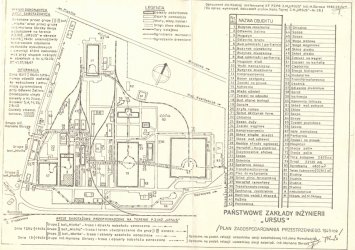
The situation plan of the action in Ursus
German mine-experts to mine the factory they used all sorts of explosive charges ranging from aircraft bombs and mortar grenades for the typically mine-like material-trinitrotoluene in packets in anebonite wrapping. Instead of impact fuses there was installed an inductive material the so-called "chicory"( the look and colour of the wrapping deceptively looked like a chicory coffee),where primers of detonators were located. Apart from connections with the ignition with the help of an electric exploder, individual nests were joined with fuses, a normal one - black and of an instant burning one - green.
The commanding officer of the platoon, the officer of the sappers an electrician by profession showed in each hall how to destroy cables and how to remove detonator primers. In the hall of the mechanics department, the assembly, the smithy and the hardening point the explosive charges were attached to the posts of load-bearing constructions of a chequered pattern. The installation for letting off the charges ran on the flyovers on which there had been running earlier electric cables for the propulsion of machines and devices.
The night was bright. Everywhere there was lying snow, there was cold around - 8 Celsius degrees. None of the action participants felt any cold - an emotion and one had to say it- fear, though the guard was on the lookout. A hard, laborious job lasted till the dawn. At the end the explosive charges were removed.
Individual groups started moving in the direction of exits in the fence. The last group that went through it was the covering one. The sections went to the headquarters while the section-representatives for the briefing. The first part of the order was carried out. The explosive charges were removed while the mine knots were destroyed. To destroy the factory Germans had to start the whole mine-action anew. But they didn't have time for that. From the southern east one could hear the rumble of the cannons.
During the briefing "Torpeda" thanked for the action and said there was the second part of the order to be done- flyovers. For clearing flyovers of the explosive charges he appointed a four-person sections. The first section of sappers was to clear the flyovers of the mines one by one, while the second section was a screen. The leadership of the whole was exercised by "Torpeda" as well.
The sappers climbed the embankment and got on the flyover, then on the load-bearing because of the flyover where on the shelves there were lying attached explosive charges. After 40 minutes of work the explosive charges were removed. There was a flyover left above the railway track to Pruszkow. Having walked 200 m it was clearly noticed against a background of the sky a German "zone" marching on the embankment. The command of Lieutenant "Torpeda" was given: "To the barracks, guns ready." The German patrol was still going on the embankment disappearing behind the turning.
Because of the dawn waking up the action on that day was called off. Unfortunately the next day Germans blew up the flyover over the railway track to Pruszkow. There was only one that stayed untouched- this that had been earlier cleared of mines.
Two days after clearing the factory halls the happiness after having fulfilled the soldierly duty was interrupted in the evening hours by an enormous explosion. "Sprengkomando" let off the rest of shells of the rail gun. They were stored opposite the iron foundry between the clinic and the entanglements for the moulding mass. Because of the explosion the following suffered: the iron foundry, the canteen building, the material magazine, in the whole factory and in the neighbouring houses all windows were broken. The rest of the factory got untouched nevertheless.
In the action of clearing the State Engineering Plant "Ursus" of mines the following soldiers of "Miotła" took part:
Kazimierz Jackowski ps. "Torpeda"
Bonifacy Dłużniewski ps. "Żmudzki"
Tadeusz Gabrysiak ps. "Kubiński"
Zenon Jackowski ps. "Adam Horski"
Czesław Józiak ps. "Żelazny"
Juliusz Kania ps. "Jan"
Zdzisław Klimaszewski ps. "Wicek"
Antoni Olszewski ps. "Wilk"
Jan Olszewski ps. "Antek"
Zbigniew Osuch ps. "Pirat I"
Jan Pęczkowski ps. "Kamiński"
Józef Powroźnik ps. "Pirat II"
Jan Romańczyk ps. "Łata"
Ochocki ps. Wujcio"
It was January 13, 2023 when in Ursus, 20 Traktorzyści street, a commemorative plaque of a heroic action taken by the Home Army "Torpeda" platoon 78 years ago was unveiled.
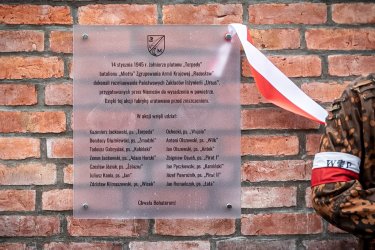
|
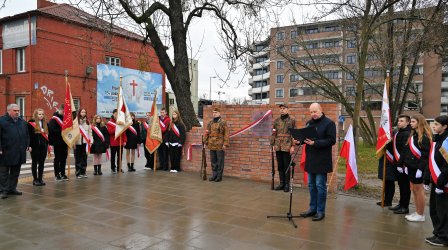
|
Jan Romańczyk
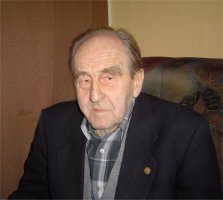
|
Jan Romanczyk
born on the 1st of May 1924 in Wolomin
sergeant cadet of Home Army
pseud. "Łukasz Łata"
Kedyw of the Main Headquarters of Home Army
"Torpeda" Platoon,
"Miotła" Battalion
"Radoslaw" Grouping
|
elaboration: Maciej Janaszek-Seydlitz
translation: Małgorzata Szyszkowska
Copyright © 2011-2023 Maciej Janaszek-Seydlitz. All rights reserved.





